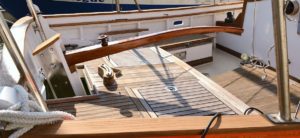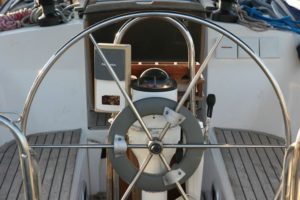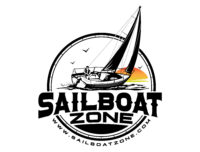So how does one steer a sailboat? Most people approach steering a sailboat the same way they would steer their car. When the steering wheel turns to the right, it steers your car to the right, etc, etc. Sailboats with a tiller are different. They have a unique and counter-intuitive way of steering. Turn the tiller to the left and the rudder will turn the boat to the right. Turn the tiller to the right and the boat will turn left. Why is this? This article will explain steering a sailboat in detail.
How does a sailboat steer?
A sailboat steers by moving the rudder which is mounted at the very back of the boat. The rudder is under the water and looks like a paddle blade or a fin. It’s job is to deflect the stream of water that flows past it when the tiller is moved left or right. The tiller is a long horizontal handle or shaft made of wood or fiberglass. It and the rudder are directly connected. This means that when the tiller is pushed to the left, the rudder swings under the right side of the boat. The result is the stern moving left and the bow steering to the right. In effect, pushing the tiller to port (left) will cause a starboard turn. Pushing the tiller to starboard (right) will cause a port turn.
Steering Commands
If you are at the tiller and someone on watch calls out “Hard to PORT!”, this means push the tiller over hard to the port side. This will cause a right turn. “Hard to PORT” does not mean steer to port (left).
The Keel
The keel of the boat is a critical component to sailing for several reasons. While sailing upwind, the keel keeps the boat from being pushed downwind. The keel is also a counterweight to the forces of the wind. It is designed to keep the boat upright. Regarding steering specifically, it is responsible for keeping the boat tracking on course. When the keel and rudder are in alignment, the boat will go straight.
When steering, the keel acts like a pivot point. As the rudder is turned and deflects the current of water flowing by, the keel and rudder will no longer be in alignment. The angle created by the rudder and keel is approximately the degree of turn the boat makes.
Steering at Speed
Sailing at higher speeds requires less steering input for intended outcome, compared to low speed steering. This is because there is a greater volume of water interacting with the keel and rudder. More water volume means greater deflection force of that water by the rudder. Sailing at lower speeds, or under power in a marina, requires more pronounced steering gestures.
What’s the difference between the tiller and the wheel?
There is a simple difference between the tiller and the wheel. A tiller will steer the boat the opposite way you move it. If you move a tiller to the left, the boat will steer to the right and vice versa. This is because of the direct connection between the rudder and the tiller.
The wheel operates exactly like a car steering wheel. The linkage which operates the mechanics of the wheel make it so when you steer to the right, the boat turns to the right and vice versa.
What is better, the tiller or the wheel?

Tiller
Tillers have their place, and are a generally preferred means of steering for boats under around 25 feet. The physical power needed to move the tiller gets rather extreme in boats over 25 feet, especially in heavier weather. Tillers have better “feel” than a wheel. You can feel the hum of the rudder and keel working together when at speed. Tillers also can be fitted with an extension, which is a clear advantage over a wheel. Tiller extensions allow the pilot to sit out on the weather rail, well past the normal arms reach of the tiller. From this position, the pilot and crew can use their weight to counter the heeling action of the boat as it beats upwind.

Ship’s Wheel
The wheel is featured more prominently in boats over 25 feet in length. The wheel is mounted on a steering pedestal. This pedestal is typically at the stern of the boat and contains the steering linkage within as well as under the deck to the rudder. Steering wheels make it possible to stand and directly face ahead. While heeled over, you can adjust your stance, placing your feet where you want in order to stand naturally. This is a great deal more comfortable than fighting gravity when you are at a tiller.
Aesthetically, wheels are a classy step up from a tiller. Practically, wheels free up a great deal of room in the cockpit compared to the tiller. Steering pedestals are usually fitted with a fold out table which is an appreciated feature, especially at anchor or moored at a wharf.
Steering with the motor
Boats equipped with outboard motors can be steered directly by that motor to ensure precision and immediacy of steering. This is very helpful, especially in very slow speed situations. I normally lock my motor in place and use the rudder for all maneuvering. If I don’t line up with my slip properly, it is still nice to grab the motor tiller and physically power my way out of trouble.
Prop Walk
There is another fascinating means of moving the boat called walking the prop. When the motor is in gear and idling, the prop will spin very slowly. If the boat is not moving forward, the slowly moving prop will pull the boat’s position sideways. If you are not prepared for this phenomenon, it can be a very confusing and frustrating thing to mentally wrestle with. However, once you get to know your boat, and you understand the direction the prop spins while in forward and reverse, you will be able to use this to your advantage.
For example, imagine your sailboat being tied to a dock, you want to leave, and the wind pins you against it. By walking the prop, you can draw your stern closer to the dock, which will put your bow further out from the dock. With your bow jutting out into the wind and held there by prop walk, you can power up and move forward into the wind and away from the dock. For props that turn right (clockwise) when in forward gear, your boat will prop walk to the right when idling. To prop walk your stern to the left, you would idle the motor in reverse gear.
Can a sailboat be steered without a rudder?
Yes, sailboats can be steered without a rudder. This is not a simple process, but one that can be done with practice, assuming there is sufficient wind. The process of steering without a rudder involves understanding the forces at work between your foresail and your mainsail. When you have too much sail out for the wind conditions, your will experience weather helm. Weather helm is when the wind overpowers your sails and the boat turns directly into the wind. This will happen if you do not steer against the weather helm. This principle is going to be put to use to steer the boat if you lose rudder control.
If you lose steering while under way, you will not be able to maintain a straight line of travel as your tack upwind. Instead you will balance between bearing away and heading up wind. In order to bear away, you need to loosen the mainsail sheet. Letting out this sheet will steer the bow away from the wind (leeward) by allowing the jib and the bow itself to be pushed away from the wind. If you want to steer closer to the wind (windward), you put the principle of weather helm to use. Tighten up the mainsheet, and the boat will weather helm into the wind. Maintaining a course is difficult if you are not attentive to the heading of the boat and the strength of the wind. When practicing this technique, it is very useful to time each maneuver. Do not spend too much time in the leeward position, and be sure to balance the windward position with equal time compared to the leeward.
Conclusion
As you can see, there is certainly a great deal involved in steering a sailboat. You can steer using a tiller or wheel, but all steering systems require a tiller. The motor also can play a roll in maneuvering the boat, specifically regarding walking the prop. Sailboats can even be steered if you lose steering altogether, provided you understand the forces at work between your jib and mainsail. Like most things related to sailing, practice is key. Make sure you have plenty of room when rehearsing all the techniques described above. Have fun!
